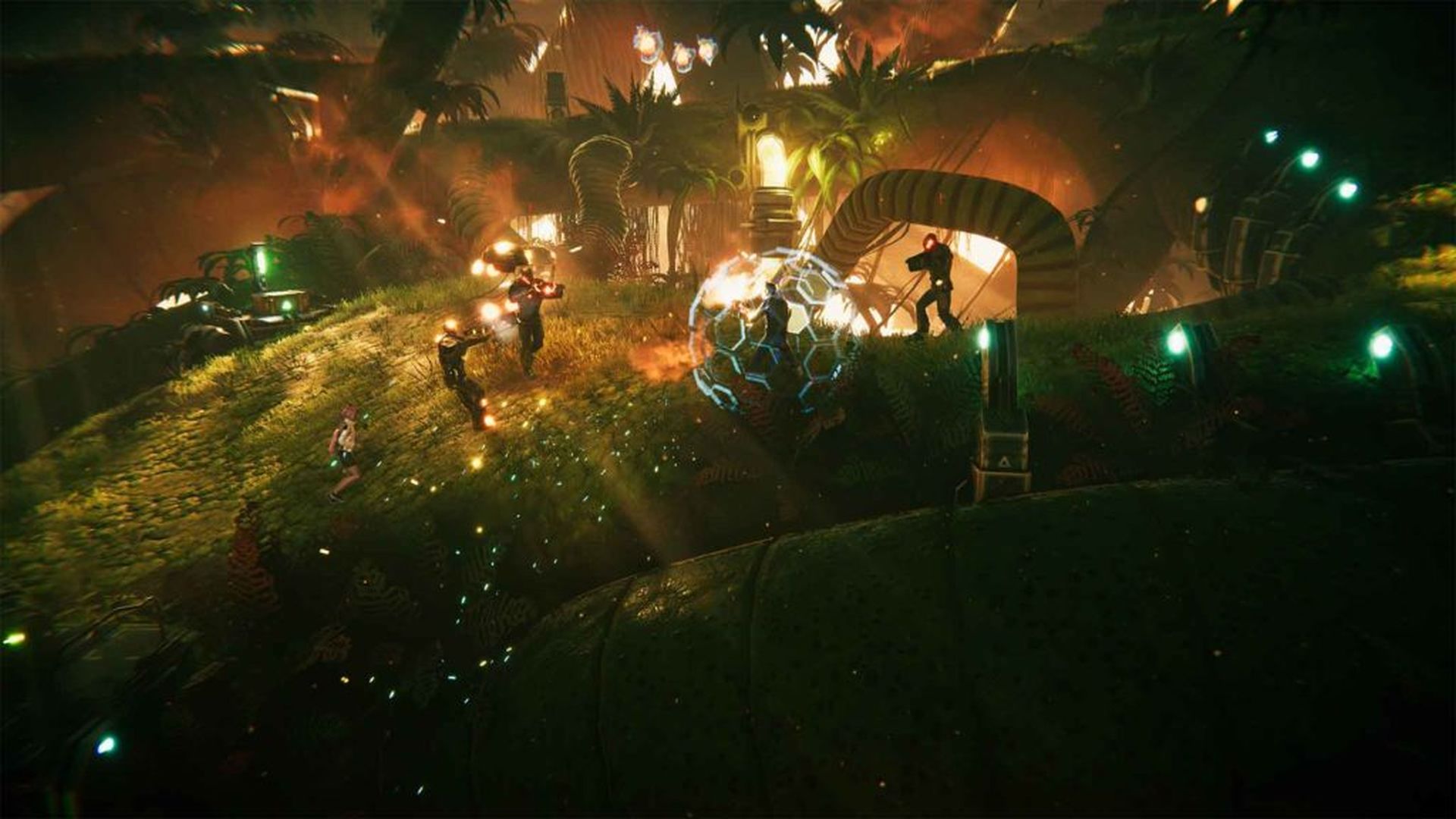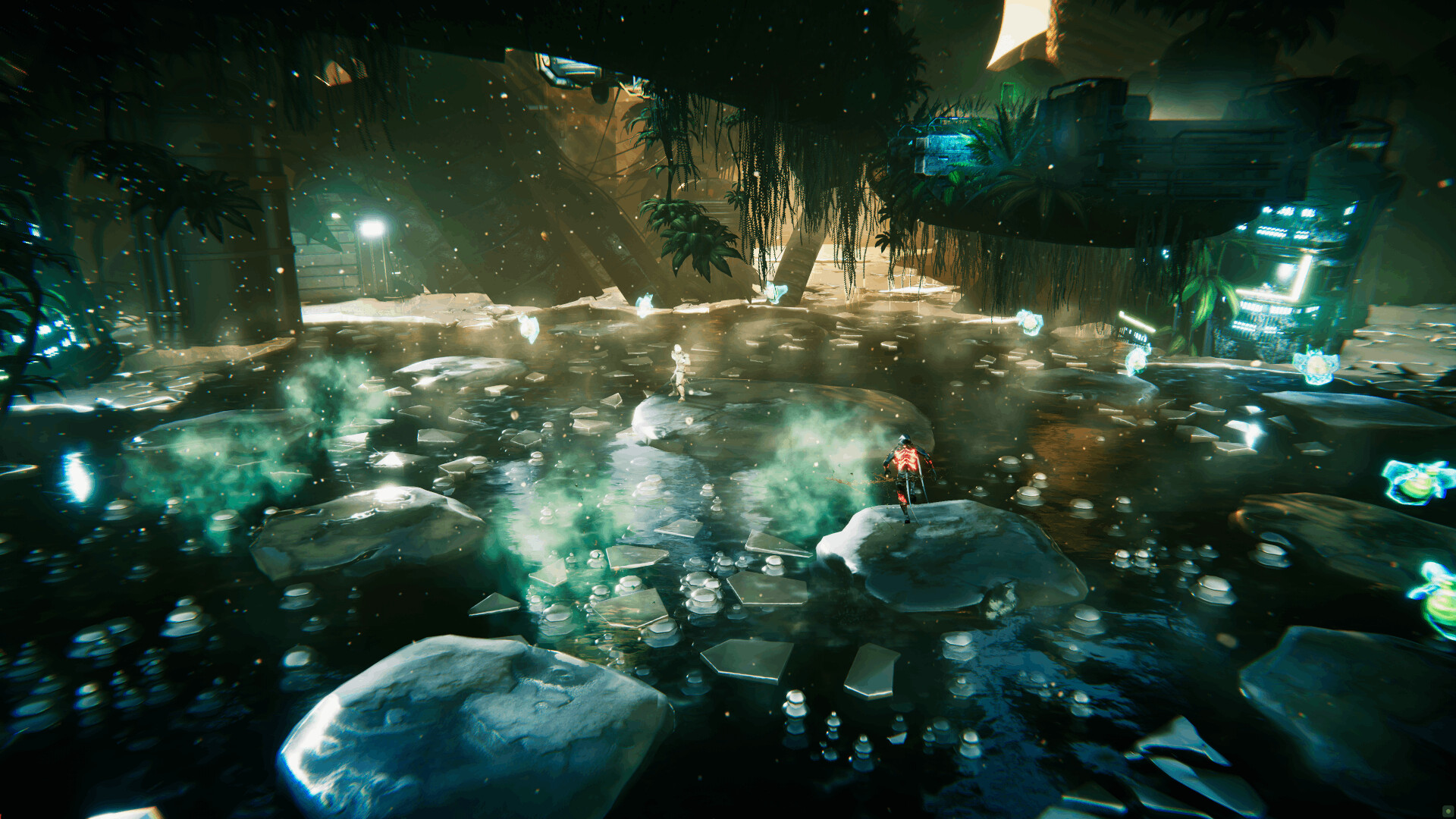You think that with 2023 nearly over, the Worst Game of the Year would be all wrapped up in terms of nominations. However, there have been several late entries these past few weeks, from Stray Souls and Skull Island: Rise of Kong to The Walking Dead: Destinies and now Flashback 2.
Unlike the other titles, Microids’ 2.5D side-scroller/shoot’ em up has a pedigree. It’s the sequel to Delphine Software International’s acclaimed 1992 sci-fi cinematic platformer, which garnered acclaim for its rotoscoped animations. The story-telling and puzzle-solving were also on point, and such was the reception that it received a sequel, Fade to Black, in 1995. So, where does Flashback 2 come in?
It starts with Conrad B. Hart, an agent of the Galactic Bureau of Investigation, awakening injured in a burned-out lab. His friend, Ian, is missing but eventually reunites with AISHA, an AI in a weapon. As Conrad emerges to an unfamiliar planet, seeking information on Ian’s whereabouts.
“The art style is appealing at times with its lighting and color palette, and the animation, while not as smooth as the original game’s rotoscoping, isn’t outright terrible.”
Overall, it’s not the worst start, even as you undertake missions to earn Credits to purchase a mech to beat a local mob boss’ opponent. You get a nice little grav bike, traverse a circular road to visit locations like Pacifica, Arctica, and whatnot, deliver packages, and learn more about the de facto evil corporation and the resistance working against them. The art style is appealing at times with its lighting and color palette, and the animation, while not as smooth as the original game’s rotoscoping, isn’t outright terrible.
However, as soon as you leave the lab, the performance starts to dip, and all sense of quality control goes out the window. A relatively fluid frame rate turns choppy, even with little action happening, turning simple exploration into a chore. Don’t worry, since the first real combat encounter introduces you to something worse: awkward controls and haphazard aiming.
Not only is taking cover pointless since you can’t pop out to shoot enemies, but you have a rechargeable shield that negates damage. Running around, dashing and using Medkits while wildly aiming, hoping to hit something – even if your cursor is directly on an enemy – is the path to success. It’s as awkward as it is unenjoyable.
Sometimes, aiming isn’t complete garbage and snaps to the intended target without issue. Other times, you can’t get it to target enemies above to save your life or progress forward. Enemies don’t react to gunfire and will die after taking enough hits, which can feel like too many at times. The game completely overloads you with Medkits, as if it knows how much of a slog combat can be and is trying to help.
“The bigger problems with Flashback 2 emerge after Helen Clark, Conrad’s friend from the GBI Academy, joins up with him.”
The 2.5D traversal, which allows for moving up and down in environments along with left and right, is also annoying. Judging your position can be tough, and it’s easy to get caught on objects, especially in some tighter areas. For a franchise with a reputation for platforming, seeing its bungled implementation in Flashback 2 is a shame.
Worse than combat and platforming is the stealth. If you’re stationary behind cover as an enemy passes by, then good, but forget moving while their backs are turned, or else you’re spotted immediately. An alarm will sound, and enemies in the area attack. Dispose of them, and things return to normal as if every other enemy in the location is blissfully unaware. It’s as dumb as it is immersion-killing.
The bigger problems with Flashback 2 emerge after Helen Clark, Conrad’s friend from the GBI Academy, joins up with him. You initially need to follow Helen and stand by while she hacks through different systems and opens the way forward. It works well enough in New Tokyo, especially as the duo evade enemy forces and constantly stay on the move. The level where Conrad must navigate a hostile ship to save Helen is also not terrible in pacing and action.
Titan Jungle is where it all falls apart. On top of iffy platforming, even worse performance, heavy-handed bloom, and new clunky mechanics, there are sections where Helen fails to follow, and the game becomes softlocked (because she’s required to progress). Reloading to a previous save is the only option. You better hope it’s a file which hasn’t been corrupted.

“Some enemies, like the cloaked Morphs, can’t turn, leading to awkward battles where they move in place, soaking up bullets before back-peddling or dying before finishing their dialogue.”
So many other things, big and small, outright ruin the experience. The so-called mech fight consists of two slow machines battling it out with no responsiveness on the only two attacks you have. Then again, the AI is terrible enough that you can get by without much trouble. Some save terminals work, and others don’t. Keep an eye out for the “Saving Game” notification at all times if you don’t want to redo some sections.
Save terminals that do work can only be activated once, which is baffling. You can’t reload your weapon without aiming. You can’t navigate menus with the D-Pad. You gain some armor which can be turned on and off, and aside from one sequence with dangerous gas, I have no clue what function it serves in combat. When using the rechargeable shield, the armor will still take damage, but your health won’t. Make it make sense.
The animation bugs out at some random points, though it corrects quickly enough. Seeing Conrad suddenly shunt off a lift for no reason is still odd, though. Some enemies, like the cloaked Morphs, can’t turn, leading to awkward battles where they move in place, soaking up bullets before back-peddling or dying before finishing their dialogue. It would be hilarious if it wasn’t so sad. At one point in Titan Jungle, the flash from security cameras before their activation started occurring on-screen, even after progressing past that section, and wouldn’t stop.
A dialogue exchange that should have played on a loading screen when traveling by spaceport instead happens when the characters are on foot and running around in the city. The bugs are seemingly unending and don’t even get me started on the NPCs who raise their hands when Conrad points his gun at them, even those on another floor before he even comes into view.

“It’s a shame because there are some sequences where the pacing gives off glimpses of a fun sci-fi spy thriller, but they’re let down by the rest of the game.”
The story can be intriguing when not ruined by embarrassing dialogue and boring plot twists (that one person you thought was an ally is actually a traitor. Gasp). Conrad comes across as cheesy, especially when interacting with AISHA, but the atmosphere feels pulpy in an 80s action movie way. That’s not great, but it’s also not outright miserable.
When Helen joins, conversations go for a toss. The Morphs have a heinous plan that could topple the order of the universe as we know it, and these teens are talking about getting coffee orders wrong while running through a dangerous jungle. It’s enough to hope for the Morphs’ plan to succeed and for humanity to fall.
It’s a shame because there are some sequences where the pacing gives off glimpses of a fun sci-fi spy thriller, but they’re let down by the rest of the game. Unfortunately, fixing all these performance issues, bugs, and odd design decisions doesn’t automatically make Flashback 2 good. Just less terrible.
The 2.5D-style movement and combat still feel horrible, and the story, even with some intriguing bits, isn’t good enough to maintain your interest. Even some impressive details in the environments do little to mask the rote level design. If you’re looking for a platformer with a decent plot and puzzles, do yourself a favor and play something else instead.
This game was reviewed on the PlayStation 5.